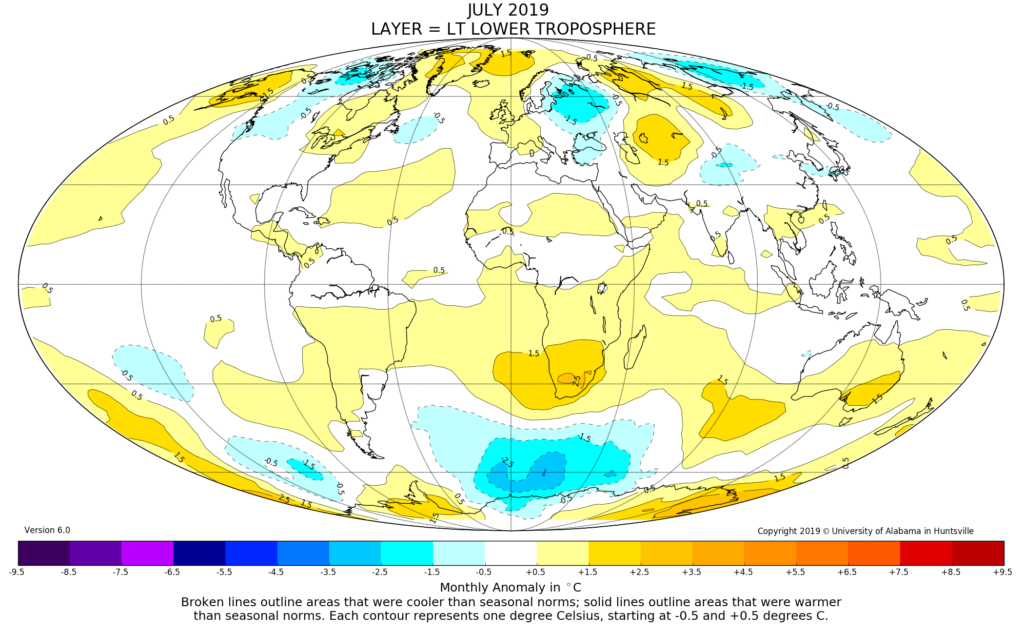Global Temperature Report: July 2019
Global climate trend since Dec. 1 1978: +0.13 C per decade
July Temperatures (preliminary)
Global composite temp.: +0.38 C (+0.68 °F) above seasonal average
Northern Hemisphere.: +0.33 C (+0.59 °F) above seasonal average
Southern Hemisphere.: +0.44 C (+0.79°F) above seasonal average
Tropics.: +0.45 C (+0.81 °F) above seasonal average
June Temperatures (final)
Global composite temp.: +0.47 C (+0.85 °F) above seasonal average
Northern Hemisphere.: +0.42 C (+0.76 °F) above seasonal average
Southern Hemisphere.: +0.52 C (+0.94°F) above seasonal average
Tropics.: +0.64 C (+1.15 °F) above seasonal average
Notes on data released August 1, 2019 (v6.0)
July’s globally-averaged, bulk-layer atmospheric temperature anomaly of +0.38°C (+0.68°F) dropped slightly from June’s value as the tropics cooled off to levels seen prior to June’s uptick. Since November 2017, global temperatures have remained in a fairly narrow range between +0.13°C and +0.47°C. This month’s global temperature may be considered tied for 2nd warmest July in the last 41 Julys (very close to July 2016’s +0.39°C) behind the El Niño inspired heat of July 1998 (+0.51°C). This drop in temperature, especially in the tropics, is an indication that the modest El Niño of 2019 is fading away.
The conterminous U.S. experienced very close to its average temperature (+0.11 °C, +0.20 °F). July of 2011 was the hottest lower-48 July as measured by our UAH dataset at +1.04 °C (+1.87 °F). However, the heat in Alaska pushed the 49-state average to +0.37 °C (+0.67°F) after two months of below average temperatures.
Though there have been several reports of July heat setting all-time record-high surface temperatures in places like Europe and Japan, the monthly average temperature of the atmosphere above these locations does not indicate anything unusual at all. These surface heat events tend to be brief and are related to weather patterns that come and go. Locations with sustained warmer-than-average temperatures for the month appeared over East Antarctica (largest global departure at +3.6 °C near McMurdo Station), South Africa, Alaska, northern Greenland, north-central Russia, Kazakhstan and southeastern Australia.
The planet’s coldest departure from average this month was -3.5 °C in the South Atlantic Ocean between Antarctica and South Africa. Other cold areas generally appear between the hot areas described above; northern Canada, western Russia, northeastern Russia and western China.
Spoiler Alert first published March 2019: As noted over the past several months in this report, the drifting of satellites NOAA-18 and NOAA-19, whose temperature errors were somewhat compensating each other, will be addressed in this updated version of data released from March 2019 onward. As we normally do in these situations we have decided to terminate ingestion of NOAA-18 observations as of 1 Jan 2017 because the corrections for its significant drift were no longer applicable. We have also applied the drift corrections for NOAA-19 now that it has started to drift far enough from its previous rather stable orbit. These actions will eliminate extra warming from NOAA-18 and extra cooling from NOAA-19. The net effect is to introduce slight changesfrom 2009 forward (when NOAA-19 began) with the largest impact on annual, global anomalies in 2017 of 0.02 °C. The 2018 global anomaly changed by only 0.003°C, from +0.228°C to +0.225°C. These changes reduce the global trend by -0.0007 °C/decade (i.e. 7 ten-thousandths of a degree) and therefore does not affect the conclusions one might draw from the dataset. The v6.0 methodology is unchanged as we normally stop ingesting satellites as they age and apply the v6.0 diurnal corrections as they drift.
To-Do List: There has been a delay in our ability to utilize and merge the new generation of microwave sensors (ATMS) on the NPP and JPSS satellites. As of now, the calibration equations applied by the agency have changed at least twice, so that the data stream contains inhomogeneities which obviously impact the type of measurements we seek. We are hoping this is resolved soon with a dataset that is built with a single, consistent set of calibration equations. In addition, the current non-drifting satellite operated by the Europeans, MetOP-B, has not yet been adjusted or “neutralized” for its seasonal peculiarities related to its unique equatorial crossing time (0930). While these MetOP-B peculiarities do not affect the long-term global trend, they do introduce error within a particular year in specific locations over land.
As part of an ongoing joint project between UAH, NOAA and NASA, Christy and Dr. Roy Spencer, an ESSC principal scientist, use data gathered by advanced microwave sounding units on NOAA, NASA and European satellites to produce temperature readings for almost all regions of the Earth. This includes remote desert, ocean and rain forest areas where reliable climate data are not otherwise available. Research Associate Rob Junod assists in the preparation of these reports.
The satellite-based instruments measure the temperature of the atmosphere from the surface up to an altitude of about eight kilometers above sea level. Once the monthly temperature data are collected and processed, they are placed in a “public” computer file for immediate access by atmospheric scientists in the U.S. and abroad.
The complete version 6 lower troposphere dataset is available here:
http://www.nsstc.uah.edu/data/msu/v6.0/tlt/uahncdc_lt_6.0.txt
Archived color maps of local temperature anomalies are available on-line at:
Neither Christy nor Spencer receives any research support or funding from oil, coal or industrial companies or organizations, or from any private or special interest groups. All of their climate research funding comes from federal and state grants or contracts.


